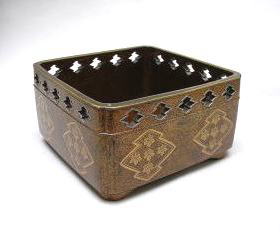Since omogashi (literary means “main sweets”) is a part of the menu of kaiseki, or a set of light meals served per person at a tea ceremony, its serving containers, kashiki, are considered as a type of kaiseki utensil and thus are principally individually provided. The most formal example of this kind of vessel is called fuchidaka, a set of stacked lacquered boxes, and its simplified versions are small plates and bowls called meimeizara or meimeibon. Besides them, larger vessels such as jikirō (container with a lid) and morikomibachi bowls are also used to hold multiple sweets for the entire guests. For the purpose of serving dried sweets (higashi), various higashibon plates, metal plates called saharibon, and takatsuki, or high-raised styled plates are employed.
In this new year exhibition, confectionery containers made of diverse materials such as ceramics and lacquerware, or in various shapes, colors and decorations are presented, including the red lacquered fuchidaka with an auspicious design of cranes holding a branch of pine tree, which is suitable to be used in new year celebrations. The richness of variation encourages you to imagine what kind of sweets are served in each kashiki.
